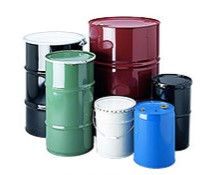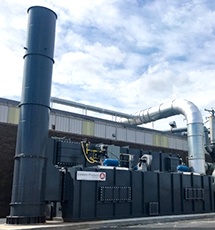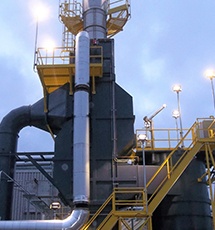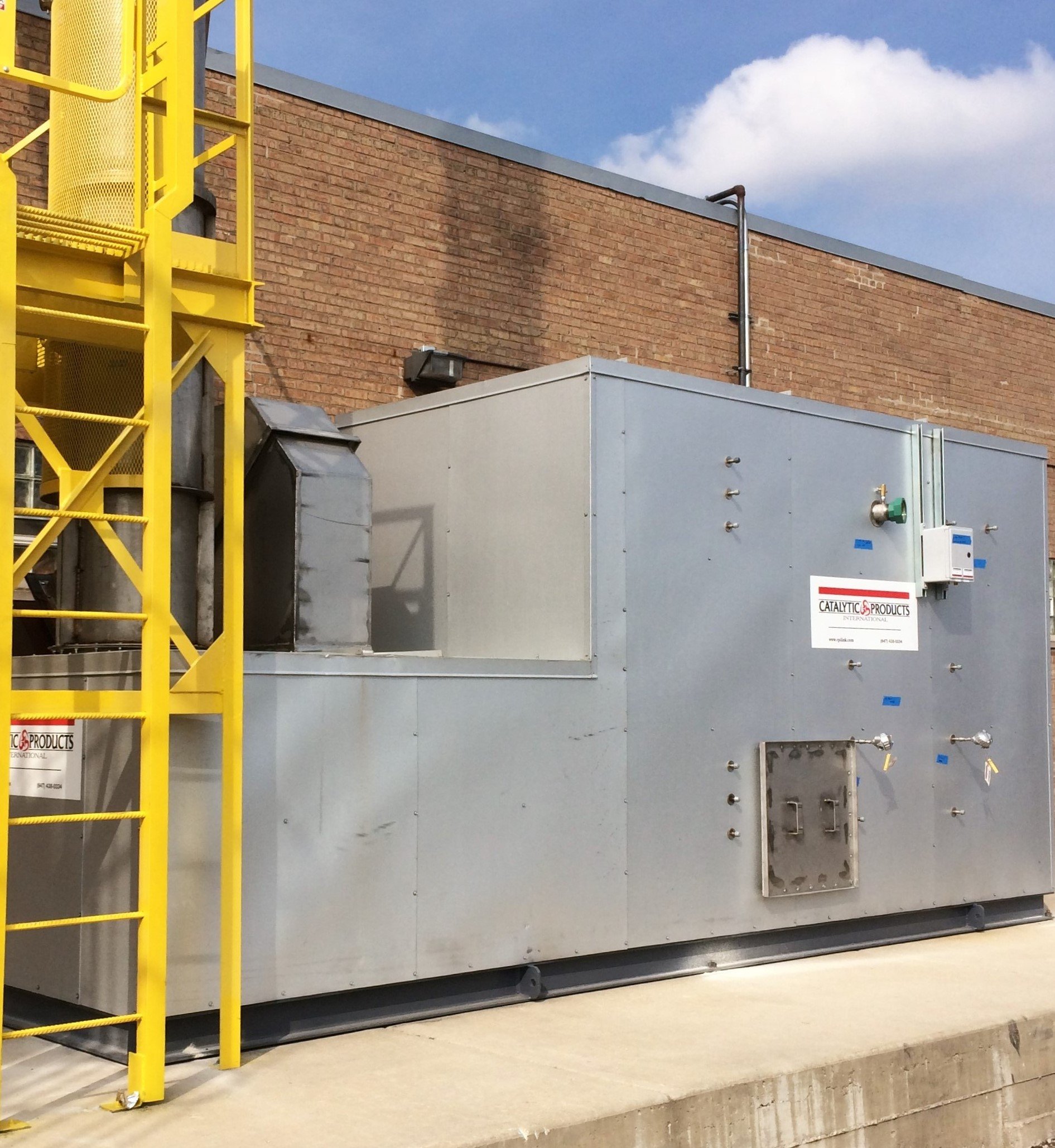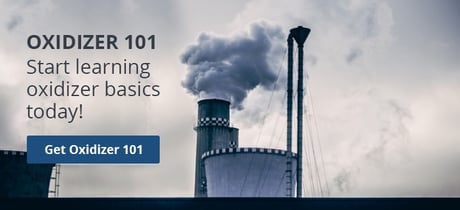One of the most common methods of transporting bulk cargo is a cylindrical container known as a drum, also referred to as a barrel. These drums are used to transport thousands of different cargo including industrial chemicals, acids (and other corrosives), oils, solvents, paints, resins, adhesives and soaps. Painted steel drums and drums made from high-density polyethylene (HDPE), typically called poly, or plastic drums, are used most often to transport and store such cargo.
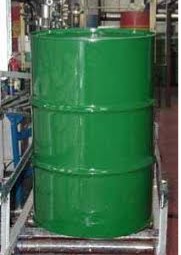
Painted steel is the most common method of construction for new drums, with a manufacturing process which can generate Volatile Organic Compounds (VOCs), hazardous air pollutants (HAPs), and odors primarily from the internal and external painting and coating processes.
In addition to the production of new drums, there is a significant market for the reconditioning or refurbishing of used containers. These reconditioned steel drums offer an environmentally and cost-effective alternative to the marketplace. The cleaning and reconditioning processes include several steps where the application of air pollution control may also be required to address VOCs, HAPs, and odors.
Recapture of these VOCs is important in the prevention of air pollution and smog. Smog is formed when VOCs react with nitrogen oxides (NOx) in the presence of sunlight. The reaction forms ground level ozone, airborne particulates, and some other pollution. VOCs are regulated as an ozone precursor under EPA’s criteria pollutant program. Areas of the country that have ozone readings above EPA guidelines are ruled nonattainment areas and have stricter regulations for VOC, CO, and NOx emissions. While odor issues related to industrial processes are not uncommon and the compounds creating the offensive odors may not be in sufficient concentrations to present a health risk, they can diminish the quality of life for the community surrounding the manufacturing or reconditioning process.
New Drum Manufacturing Process
One of the final steps in the manufacturing of new steel drums involves painting and coating of the drums during which Volatile Organic Compounds (VOCs) and odors are released into the environment. The main objective of this process is to improve the aesthetic and to reduce the corrosion of the drums. After the drum parts are cleaned and assembled, the drums are first conveyed through the interior lining paint spray booth and drying oven followed by the exterior paint spray booth and drying oven. 0020The drum lids are also conveyed through a paint spray booth and drying oven for finishing.
The following processes in new drum/container manufacturing may generate significant emissions of VOCs and odors:
- Interior Lining Paint Booth & Curing Oven
- Exterior Paint Booth & Curing Oven
- Drum Lid Paint Booth & Curing Oven
Reconditioning Process
Industrial Container and Drum Cleaning (ICDC) facilities clean and recondition metal and plastic drums and intermediate bulk containers (IBCs) for resale, reuse, or disposal. The reconditioning process includes the cleaning, restoring, testing, and certifying of industrial containers which may have previously contained materials such as paints, resins, tars, adhesives, oils, soaps, solvents, cleaners, or related materials. The interiors and exteriors of the drums are cleaned and reconditioned to prevent contamination of materials from one cargo shipment to the next and to ensure the integrity of the containers.
Industrial container and drum cleaning (ICDC) and reconditioning may include the following processes where VOCs and odors may be emitted:
- Aquatic Wash Process for Cleaning Bung-Type Drums
- Sequential wash processing steps which may include caustic washing as well as acid cleaning or etching.
- VOCs may be exhausted to a packed tower scrubber; however, the non-water-soluble VOCs and odors require thermal treatment to be destroyed.
- Thermal Process for Cleaning Open-Head Steel Drums
- Conveyed through a drum reclamation furnace at approximately 1,200 degrees Fahrenheit with exhaust gas ducted to an afterburner at approximately 1,800 degrees Fahrenheit to control VOC emissions.
- Paint Booth Exhaust
- Curing Oven Exhaust
VOC and Odor Control
Thermal oxidizers, or afterburners, are an effective method of controlling the VOCs, HAPs, and odor causing compounds from new drum manufacturing and drum reconditioning processes. Thermal treatment of VOCs and other air pollutants works by a simple reaction of the harmful hydrocarbon-based air pollutants with oxygen and heat. In this environment, the VOCs are chemically oxidized to form harmless inert by-products like CO2, water vapor (H2O) and usable heat. These harmless by-products are released to the atmosphere or used within primary or secondary energy recovery techniques to further lower the operational costs.
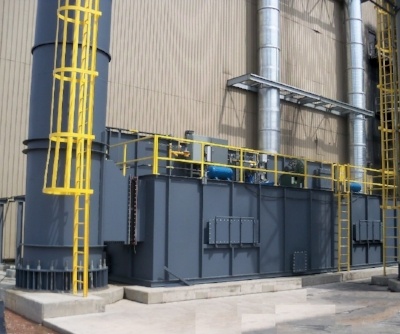
The most commonly used thermal oxidizer, is a Regenerative Thermal Oxidizer or RTO. During operation of an RTO the VOCs are ducted into one of the system’s regenerators, an internally insulated vessel containing specialized ceramic media which allows thermal rate efficiencies up to 97%. The contaminated gases are passed through the first regenerator where energy is transferred from the ceramic media to the gases in order to elevate the temperature of the gases. After reaching this elevated temperature which approaches the ignition level for most solvents, the gases are directed to the internally lined combustion chamber. In the combustion chamber minimal heat is added to ensure a proper oxidation temperature and designed dwell time and turbulence are maintained providing destruction of the VOCs at greater than 98% efficiency. The resultant clean, oxidized gases are redirected into the second regenerator bed to continue the energy transfer and oxidation cycle before being released to the atmosphere.
Emissions Capture
Collection of VOC emissions (referred to as “capture”) and the removal of collected VOC emissions from the exhaust air stream using an air pollution control device (referred to as “control”) are critical components in determining the “overall control” or control efficiency of a VOC destruction system. While most thermal oxidizers typically destroy or control more than 98% of all VOCs, fugitive VOC emissions are often the largest contributor affecting overall VOC control. Capture systems designed to eliminate fugitive emissions can include Close Capture Hooding, Permanent Total Enclosures (PTE), and Temporary Total Enclosures (TTE). Efficient capture of emissions in drum manufacturing and reconditioning facilities requires an effective method of ensuring the collection and routing of VOCs from the cleaning and painting operations to the control device such as an oxidizer.
Since 1969 Catalytic Products International (CPI) has been providing industry leading companies with solutions to their air pollution control needs.
Today, CPI partners with its customers as a trusted resource in resolving the most complex air pollution and energy conservation problems. We provide our customers with innovative and cost-conscious solutions to their most complex VOC, NOx, and Odor pollution challenges. Our equipment is also at work meeting energy conservation strategies and minimizing greenhouse gas (GHG) emissions.

